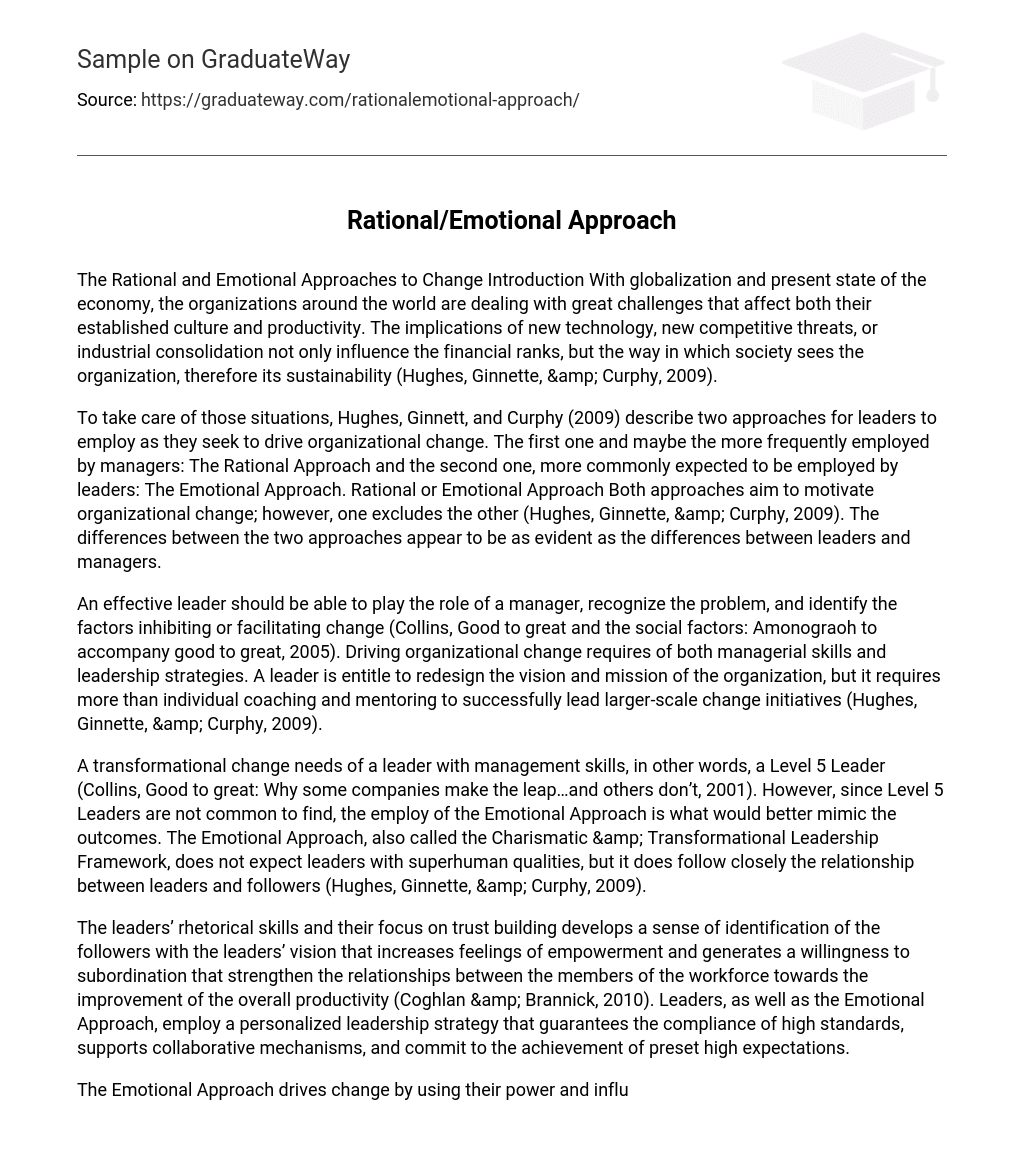The Rational and Emotional Approaches to Change Introduction With globalization and present state of the economy, the organizations around the world are dealing with great challenges that affect both their established culture and productivity. The implications of new technology, new competitive threats, or industrial consolidation not only influence the financial ranks, but the way in which society sees the organization, therefore its sustainability (Hughes, Ginnette, & Curphy, 2009).
To take care of those situations, Hughes, Ginnett, and Curphy (2009) describe two approaches for leaders to employ as they seek to drive organizational change. The first one and maybe the more frequently employed by managers: The Rational Approach and the second one, more commonly expected to be employed by leaders: The Emotional Approach. Rational or Emotional Approach Both approaches aim to motivate organizational change; however, one excludes the other (Hughes, Ginnette, & Curphy, 2009). The differences between the two approaches appear to be as evident as the differences between leaders and managers.
An effective leader should be able to play the role of a manager, recognize the problem, and identify the factors inhibiting or facilitating change (Collins, Good to great and the social factors: Amonograoh to accompany good to great, 2005). Driving organizational change requires of both managerial skills and leadership strategies. A leader is entitle to redesign the vision and mission of the organization, but it requires more than individual coaching and mentoring to successfully lead larger-scale change initiatives (Hughes, Ginnette, & Curphy, 2009).
A transformational change needs of a leader with management skills, in other words, a Level 5 Leader (Collins, Good to great: Why some companies make the leap…and others don’t, 2001). However, since Level 5 Leaders are not common to find, the employ of the Emotional Approach is what would better mimic the outcomes. The Emotional Approach, also called the Charismatic & Transformational Leadership Framework, does not expect leaders with superhuman qualities, but it does follow closely the relationship between leaders and followers (Hughes, Ginnette, & Curphy, 2009).
The leaders’ rhetorical skills and their focus on trust building develops a sense of identification of the followers with the leaders’ vision that increases feelings of empowerment and generates a willingness to subordination that strengthen the relationships between the members of the workforce towards the improvement of the overall productivity (Coghlan & Brannick, 2010). Leaders, as well as the Emotional Approach, employ a personalized leadership strategy that guarantees the compliance of high standards, supports collaborative mechanisms, and commit to the achievement of preset high expectations.
The Emotional Approach drives change by using their power and influence, personality, traits, coaching, planning skills, and knowledge of motivational techniques (Hughes, Ginnette, & Curphy, 2009). However, if the leaders or the organization is not ready to move a step forward, either because they are not technologically prepared or economically strong to do it; the mere Emotional Approach is not going to be enough. If what is on table is just a short-term goal, who could play a better lead role in sustainability? The answer is simple: a manager and the employment of a Rational Approach.
When there are not enough infrastructures to make big changes, or to transform the vision of an entire organization, it is better just to do things right. The Rational Approach controls budget and costs, and administers the programs that leaders, often under the use of the Emotional Approach, previously developed. The problem starts when the managers, and because of their resistance to change, promote the failure of plans of action just because they interrupt the status quo (Coghlan & Brannick, 2010) (Hughes, Ginnette, & Curphy, 2009).
This situation increases followers’ dissatisfaction, and the inability to address the issues that originally began the change. Understanding the explanatory power of the model, the rational approach to change gives leaders a useful heuristic for driving organizational and community change. Conclusion The rational approach puts more emphasis on analytic, planning, and management skills whereas the emotional approach puts more emphasis on leadership skills, leader follower relationships, and the presence of a crisis to drive organizational change.
There is ample evidence to suggest that either the rational or the emotional approach can result in organizational change, but the effectiveness of the change may depend on the approach leadership practitioners are most comfortable with and the skill with which they can carry it out. Should not leaders and managers integrate the factors and use both the Rational and the Emotional Approach? References Coghlan, D. , & Brannick, T. (2010).
Doing action research in your own organization (3rd ed. ). Thousand Oaks, CA: Sage. Collins, J. (2001, Collins Business. ). Good to great: Why some companies make the leap…and others don’t. New York, NY: Collins Business. Collins, J. (2005). Good to great and the social factors: Amonograoh to accompany good to great. New York, NY: Harper Collins. Hughes, R. L. , Ginnette, R. D. , & Curphy, G. J. (2009). Leadership: Enhancing the lessons of experience, 6th Edition. Irwin/McGraw-Hill.





